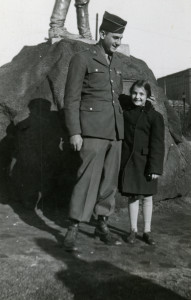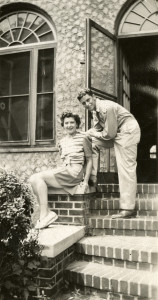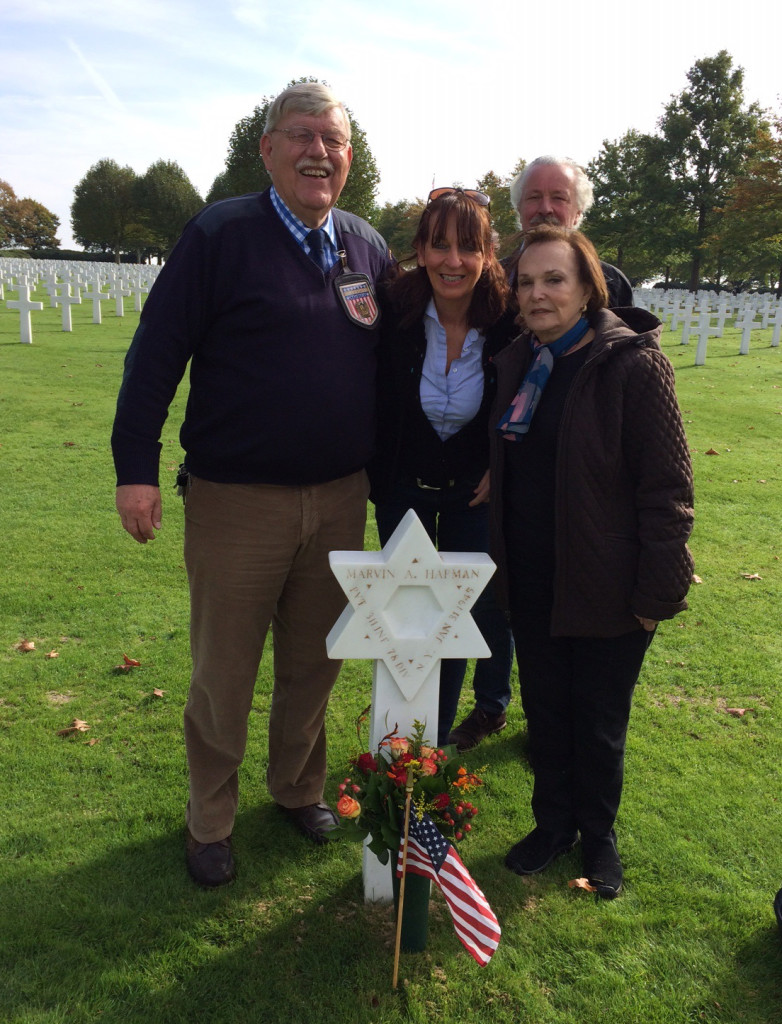Reuniting Old Friends: A Collection’s Story
As the Collections Manager at The National WWII Museum, I am allowed the privilege of interacting with collection donors, often WWII veterans and their families. This is one of my favorite parts of the job. These collections almost always come to us with a story. Here is one story that I’d like to share.
In 1944, Ann Lehman was eight years old when her brother Alfred enlisted in the Army and shipped off for Europe along with his friend Marvin Harman. Ann’s mother Henrietta was a widow that worked hard to take care of her family in Forest Hills, Queens, New York.

Alfred and Ann Lehman in Providence, Rhode Island, Thanksgiving 1944. Gift in Memory of Alfred Lehman, 2013.342
After Alfred’s death in 2006, Ann donated her brother’s wartime scrapbook to the Museum. The scrapbook tells the story of Alfred’s journey through Europe with Company K of the Army’s 319th Infantry Regiment, 80th Infantry Division. Alfred saw fierce action during the Battle of the Bulge and after the war returned home to his family in New York. She included a few additional family photos taken just prior to her brother shipping out as well as one showing a proud Ruth Harman with her smiling 18-year-old son on the stoop of their Brooklyn home. Ann told me that Marvin was killed during the war and she wanted to include a picture of him so that he might be remembered. She didn’t know what had happened to her friend, as Marvin’s mother, also a widow, had become distant from Ann and her family after being notified of her son’s death. Ann had heard that Marvin was buried somewhere in Holland but was unsure about the details. She worried that her single photo of Marvin might be all that was left of him. Ann recounted:
“I remember when I was about eight years old in camp, Marvin, my brother and I were standing near the lake. Marvin spoke to me with such sweetness and warmth that made him so different than most of the people I knew.”
While researching Marvin’s service, I was able to locate his grave at the American Cemetery at Margraten in the Netherlands. Marvin enlisted in New York on September 23rd 1943 and served with the 311th Infantry Regiment, 78th Division. He was killed in action on January 31st of 1945 during the final battle of Kesternich, Germany, 20 miles from Aachen. Marvin was posthumously awarded the Purple Heart. I passed this information on to Ann and hoped it might offer her some closure and solace. I contacted the cemetery and discovered that Marvin’s grave had been adopted and maintained since 1946. Marvin had definitely not been forgotten.
After emails on Ann’s behalf with the grave adoption agency in Holland, I put Ann in touch with the family maintaining her friend’s grave. She wrote to them:
“I would like to thank you for looking after a most wonderful boy’s grave. My oldest brother Alfred Lehman was a friend of Marvin’s, we all went to the same summer camp. Marvin was Ruth Harman’s only child and she had lost her husband.
In January 1945 I was almost nine years old. I can tell you this about Marvin, whoever knew Marvin loved him, including me. Over the years I have met people that knew him and they expressed the same feelings. He was a very special person and [his death was] a great loss to all that knew him. Nineteen years old was too young to die. May god bless you for what you are doing.”

Ruth Harman with her son Private Marvin Harman in Brooklyn, New York in Summer 1944. Gift in Memory of Marvin Harman, 2013.342.
Ann received the following response from the family looking after Marvin’s grave:
“I want to thank you for the time you took to search for the grave of Marvin, and me. . . .I can tell you that I adopted Marvin’s grave eight years ago but I was not the first. There was another woman in Maastricht who had adopted it in 1946. The woman in Maastricht who adopted the grave had lost her husband in a camp in Germany. Did Marvin’s mother ever have a chance to visit the grave of her son? I bring flowers to Marvin’s grave 3 or 4 times a year with my husband and our 2 sons. Sometimes there lies a white rose. I suppose that someone from the family in Maastricht still comes and visits him also. Whenever we visit Marvin’s grave at the cemetery we see all of those boys’ names on so many graves, it is difficult for my eyes to stay dry.”
Ann provided the family with the picture of Marvin, who until this time, had only been represented to them by a stone marker in the cemetery:
“I am so moved with this picture of Marvin and his mother. He was exactly as you described him…a beautiful boy! You can see from his face that he was a very kind person. His mother is so young and pretty. It must have been so painful for her to receive the awful news about her son. She seems so happy in this picture.”
Last year Ann paid a visit to her old friend Marvin in Holland and she made a few new acquaintances, Marjo and Winny Habets and their sons, the caretakers of Marvin’s grave. Ann keeps in touch with the Habets on a weekly basis and they have become close friends. Their conversations often, but not always, touch on Marvin. She is contemplating another visit to Margraten in May of this year.

(From left to right), Margraten Cemetery staff member Cecil Buis, Marjo Habets, Winny Habets, and Ann Lehman Brownstein at The Netherlands American Cemetery at Margraten in 2014. Photo courtesy of Ann Lehman Brownstein.
Learn more about the Foundation for Adopting Graves at the American Cemetery in Margraten (Stichting Adoptie Graven Amerikaanse Begraafplaats Margraten) and the Netherlands American Cemetery.
Posted by Lowell Bassett, Collections Manager at The National WWII Museum.
- Posted :
- Post Category :
- Tags : Tags: Kesternich, KIA, Lowell Bassett, Margraten
- Follow responses to this entry through the RSS 2.0 feed. You can skip to the end and leave a response. Pinging is currently not allowed.




Leave a Reply